6 Days in Sunny Southern Italy
Loaded with history and character, the South of Italy will make your five senses work like never before. The region is colloquially known as Mezzogiorno (“midday”) for the intensity of the solar noon. And it seems that everything here is amplified: wild sun-kissed countryside, rich southern flavors, fiery Italian charisma…This week-long tour will show you Southern Italy in all its glory. You’ll explore its UNESCO-listed ruins, enjoy dazzling villas and palaces, explore its charming towns, and chat with friendly locals!And don’t sweat it if your plane lands in Rome. You can book our private cars from Rome Fiumicino Airport to Naples and back, and discover even more of Italy!
Your Southern Italy Itinerary:
Day 1: Naples to Positano (stops in: Mount Vesuvius, Cantine del Vesuvio, Pompeii)
Day 2: Positano to Salerno (stops in: Villa Cimbrone, Villa di Poppea)
Day 3: Salerno to Matera (stops in: Paestum, Certosa di Padula)
Day 4: Matera to Lecce (stops in: Crypt of Original Sin, Gioia del Colle)
Day 5: Lecce to Bari (stops in: Basilica of San Martino, Alberobello, Castellana Caves)
Day 6: Bari to Naples (stops in: Castel del Monte, Benevento, Royal Palace of Caserta)
Day 1: Naples to Positano
Vivacious, chaotic and colorful, Naples has a very distinct character that is worth experiencing first-hand. One of the oldest cities in Europe, Naples definitely has a lot to show for all those years. Its UNESCO-protected city center, one of the biggest in the world, is packed with history. 448 historical churches, 3 castles, and 2 royal palaces is just a small part of what to do in Naples. Start unraveling the web from Piazza del Plebiscito where you’ll see some of the main sites: Palazzo Reale, San Francesco di Paola Church, Galleria Umberto I, and Teatro San Carlo. For a bit of a breeze, walk the promenade from the impressive Castel Nuovo to Castel dell'Ovo, oldest surviving fortification in Naples.Hide from the sun in one of Naples’ many museums. Whether you’re into archaeology or visual arts, you’re bound to find something worthwhile. The National Archaeological Museum has a remarkable collection of Roman artifacts, those excavated in Pompeii and Herculaneum. Museo di Capodimonte, on the other hand, displays paintings by some of the most important artists in history, such as Caravaggio, Titian, Raphael and El Greco.And whatever you do, eat as often as possible in Naples! With its pizza, pasta, pastries and coffee, the local cuisine is some of the best in the world!When you've had your fill, experience the best way to get from Naples to Positano!
Mount Vesuvius
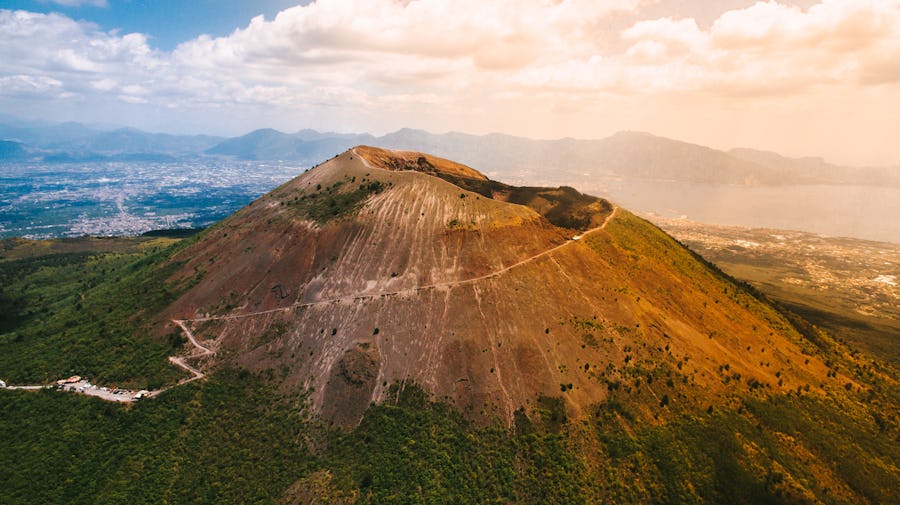
Make a first stop on your Southern Italy tour 2-hours at Mt. Vesuvius. The volcano in many ways has determined the fate of the region. It buried the cities of Pompeii and Herculaneum during its eruption in 79 AD. An easy 15 minute walk from the national park entrance will take you right to the rim of the crater. As you find yourself standing between the imposing volcano and the stunning Bay of Naples, take a moment to remember that Vesuvius remains active to this day.
Cantina del Vesuvio

While Vesuvius has destroyed cities, it also blessed the region with fertile, volcanic soil. Experience the fruits of Southern Italy by spending 2 hours at this family-owned winery. They're renowned for their Lacryma Christi, the fist vines of which are said to have been watered with Christ’s tears upon Lucifer's fall from heaven. Every year Cantina del Vesuvio produces a limited number of bottles. Book your 2-hour visit to the vineyard and taste the delicious wine paired with local foods!
Pompeii
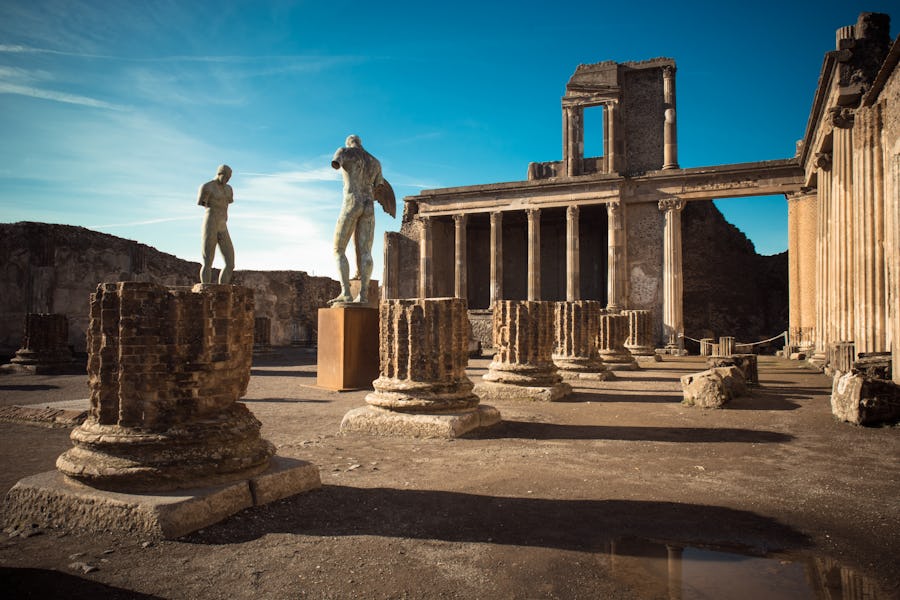
One of the more uniquely preserved archaeological sites in the world, Pompeii still occupies the minds of people even almost 2000 years after its tragedy. Buried under Vesivius’ volcanic ash and debris in 79 AD, this once flourishing Roman city lay forgotten until the 16th century. First excavations began 200 years later uncovering a slice of history that has given fascinating insights into the daily life of ancient Rome. The ruins cover a vast area of 440,000 m2; we recommend you plan your visit in advance or hire a guide for your 2-hour (or more!) visit!
Arrival in Positano

Postcard-perfect Positano is one of the best places to stay on the Amalfi coast. Looking at this beautiful town perched on a steep cliff you’d never believe it once was a struggling fishing village. In 1953, John Steinbeck put a spotlight on Positano with a travel essay published in Harper's Bazaar. Suddenly, everyone wanted to experience “a dream place that isn’t quite real when you are there and becomes beckoningly real after you have gone”. Legend has it that Poseidon created Positano out of love for a nymph named Pasitea. And as you look at the cascade of pastel houses reaching the turquoise waters of the sea, it’s quite easy to believe this romantic story.With hundreds of steep stairs and winding streets, this vertical city is best explored by foot. It won’t be easy but the beauty awaiting you at every turn will be well worth it. And trust us, you’ll be taking lots of breaks because the town’s art galleries, restaurants and shops are hard to pass up. Make sure to visit the church of Santa Maria Assunta with its colorful majolica-tiled dome and a 13th century Byzantine icon of a black Madonna.If you choose to stay in Positano for a few days, we recommend going on a boat tour to Capri. The island’s magnificent villas and the iconic Blue Grotto won’t disappoint. Duration with stops: 8 hours and 32 minutesBook a private car from Naples to Positano
Day 2: Positano to Salerno
After a slice of Amalfi paradise travel from Positano to Salerno on the other side of the Amalfi Coast.
Ravello
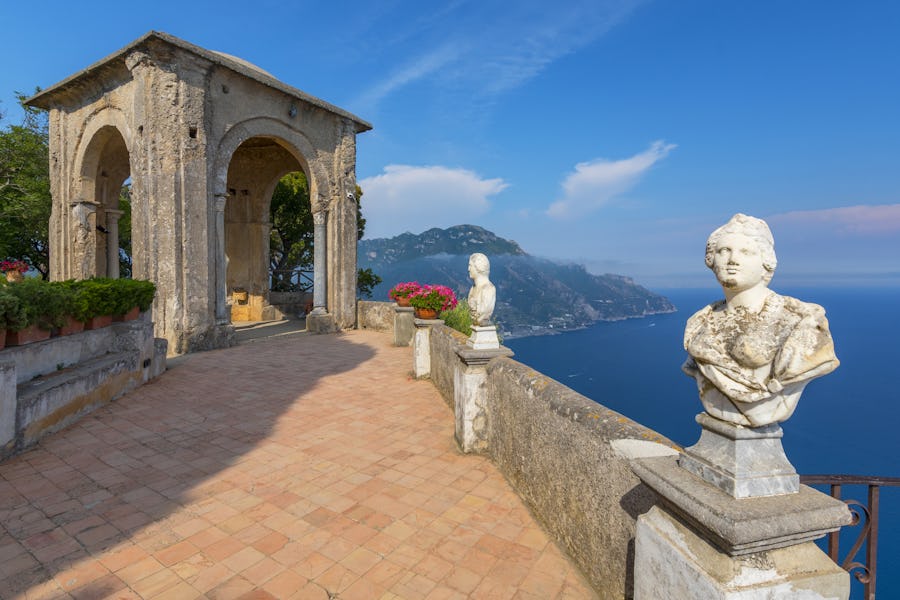
The medieval hilltop town of Ravello is one of the most scenic in the entire Amalfi Coast. The main draw being its two UNESCO-listed villas. During your 90 minute visit, be sure to visit both! The 13th century Villa Rufolo and its gardens, was Wagner's inspiration for the garden of Klingsor in his opera Parsifal. Meanwhile, the 11th century Villa Cimbrone boasts what Gore Vidal described as the most beautiful place on the planet: the belvedere. Lined with marble busts and accented with a pseudo-Roman temple, this overlook on a sheer cliff face gives spectacular views of the Amalfi Coast.
Villa di Poppea

Buried in the same eruption as Pompeii and Herculaneum, Villa di Poppea was found in the 1590s during the construction of the Sarno canal. In the following centuries many attempts at excavations have been made, with the most systematic beginning in 1964. However, to this day only about 60% of this large complex has been dug out because of its proximity to the new city structures. Owned by the Emperor Nero, the villa is presumed to have been the second residence of his second wife, Poppaea. This magnificent villa with its lavish frescoes and mosaics will show you how Roman nobility lived in the 1st century during your 90-minute visit.
Arrival in Salerno
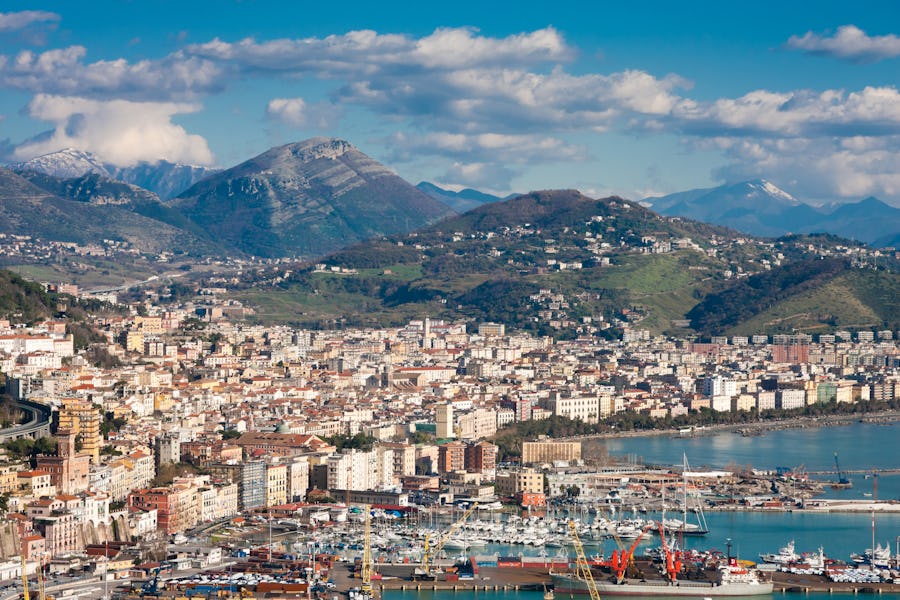
This ancient city is often overlooked as a destination due to its proximity to the Amalfi Coast. Founded around 197 BC, Salerno flourished under the rule of the Lombard dukes becoming the European center of medical studies in the Middle Ages. Its winding history even saw Salerno to become the capital of Italy for 6 brief months in 1944. King Victor Emmanuel III, who had just withdrawn his support for Mussolini and announced an armistice with the Allies, fled Rome fearing retribution from the advancing German forces.Salerno’s well-maintained historic center is dotted with palaces, churches, restaurants and shops. Begin from the 11th century Cathedral of San Matteo that you’ll find by its spectacular bell tower. The stunning Romanesque exteriors are complemented by a fabulous crypt and intricate mosaics inside. To learn more about Salerno’s contributions to medical knowledge, stop by the Museum of the Salerno Medical School. Atop a 300-meter hill, medieval Arechi castle offers incredible views on the city and the Gulf of Salerno. From there get to the 2 km-long Lungomare Trieste for a satisfying walk along the seaside. Duration with stops: 5 hours and 20 minutesBook a private car from Positano to Salerno
Day 3: Salerno to Matera
After getting your dose of Italy's coast, start head inland from Salerno to Matera.
Paestum
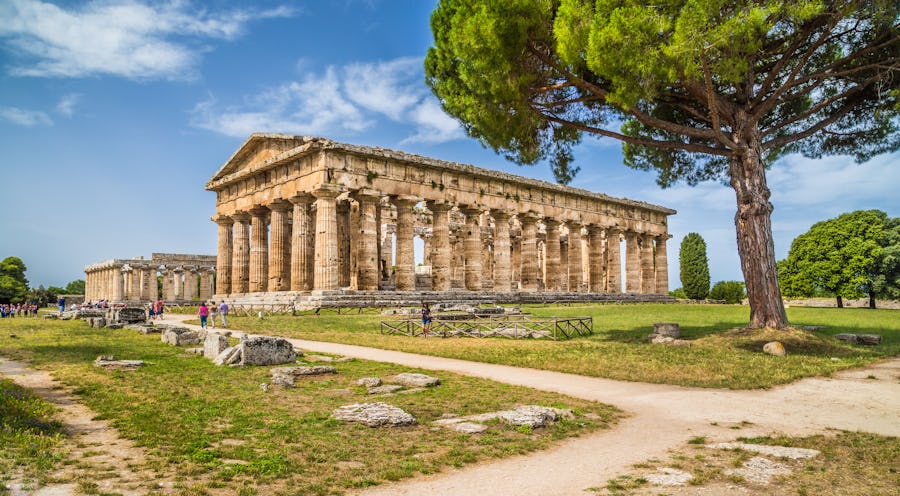
The ruins of the ancient Greek settlement of Paestum are a UNESCO World Heritage Site renowned for their magnificently preserved Doric temples and painted tombs. The three iconic temples dedicated to Hera, Poseidon and Athena were built between 550 and 450 BC. Today you can even walk through the two of them! Set aside some time during your 2-hour visit to see the artefacts exhibited at the museum. The funerary frescoes, most notably the one from the Tomb of the Diver, will definitely impress you!
Certosa di Padula

This UNESCO World Heritage Site is definitely one of the most impressive spots in Southern Italy. The grandiose complex covers 51,500 m², with the cloister taking up almost a quarter of the space. The monastery, which is still in use, was founded in the 14th century but its most recognized elements were added in the Baroque era. Explore Cestosa’s 350 rooms for 2 hours to find the stunning white marble spiral staircase, the library’s floor covered in Vietri ceramic tiles, and the finely decorated chapels.
Arrival in Matera
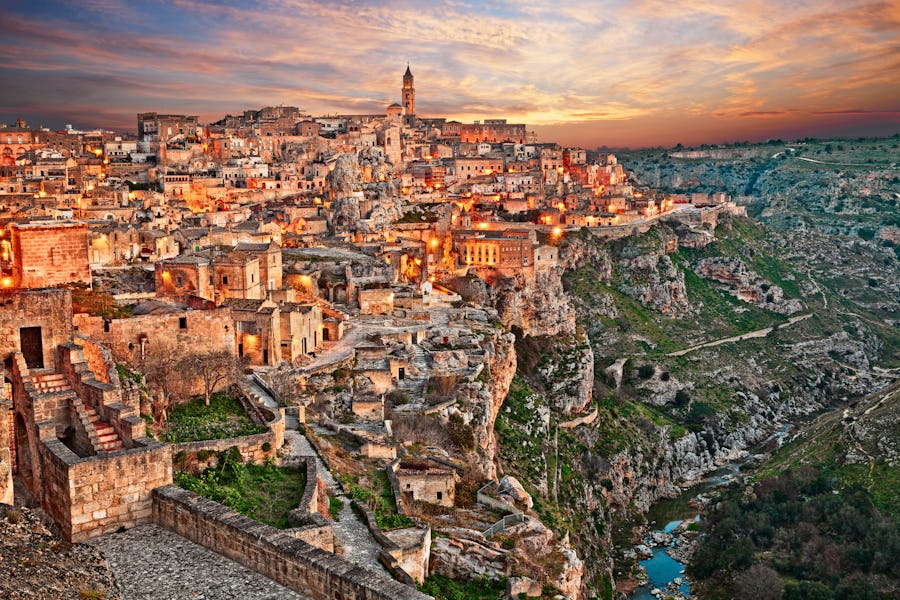
Located in the region of Basilicata, Matera is unlike anything you’ve seen before. The troglodyte city of Sassi di Matera was carved into the limestone of La Gravina ravine. Continuously inhabited for the past 9000 years, it's one of the oldest settlements of its kind. Today these extraordinary UNESCO-listed cave dwellings house the city’s most thriving restaurants, hotels, museums and galleries. But less than 80 years ago, the extreme poverty and harsh living conditions made it a national disgrace. The caves’ bad reputation persisted even after the population relocated in the 1950s, until the new administration saw the underground city’s potential. For its striking resemblance to old biblical cities, Matera has become Hollywood’s darling providing the backdrop for many films.The best way to explore the city is to set out into the labyrinth of its cave districts. Matera’s churches that range from simple cave altars to elaborate complexes are of particular interest. Stop by the 12th-century Chiesa San Pietro Barisano with its incredible frescoes, find Chiesa di Santa Maria di Idris for the spectacular views, and finish the day by the 13th century Matera Cathedral visible from everywhere in the city. Duration with stops: 8 hours and 13 minutesBook a private car from Salerno to Matera
Day 4: Matera to Lecce
After getting a proper workout hiking the cave-riddled hills, head from Matera to Lecce.
Crypt of Original Sin

Aptly nicknamed the “Sistine Chapel of Rupestrian Art”, this cave is a must-see! The church’s unique 9th century wall art depicts biblical scenes, one of which gave the name to the crypt. Dotted with distinctive red flowers, a monk who came to Italy from Eastern Europe or Asia Minor presumably painted the crypt. Make sure to book your 60-minute visit in advance as this UNESCO-protected site has limited capacity!
Gioia del Colle
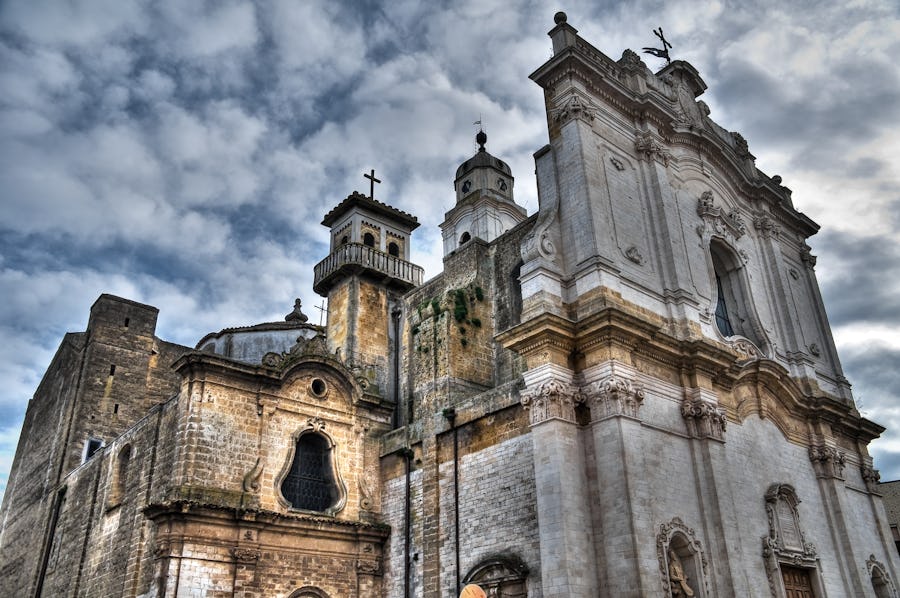
Famous for its wine and mozzarella, Gioia del Colle is a hidden gem of Apulia. During your 90-minute visit, stop by one of the vineyards to taste the rich wines made out of the Primitivo red grape. Those interested in history and culture will also have a great time here! Take a walk through the town center to see the beautiful churches and spot all the historic arches that marked the entrances to noble palaces. Another important site is Gioia del Colle’s 12th century castle, which became Emperor Frederick II’s residence following his return from the 9th Crusade.
Arrival in Lecce

Known as the “Florence of the South” for its stunning Baroque architecture, Lecce is arguably the most put-together city south of Naples. The soft and responsive local limestone birthed the distinctly detailed Barocco Leccese.First go to Piazza Sant'Oronzo for the 2nd-century Roman amphitheatre, still half buried under the city. From there you can walk to the more intimate Piazza del Duomo with the Lecce Cathedral. Originally built in the 12th century, the cathedral received a new bell tower and a Baroque makeover in the 1660s. The highlight of Barocco Leccese is undeniably the extravagant Basilica di Santa Croce. Covered with animals, flowers, plants, and cherubs, its extremely ornate facade has been described both as a masterpiece and a lunatic having a nightmare. After this, the view of the Church of Saints Niccolo’ and Cataldo, located just outside the old center, will be a bit more sobering. This 12th-century Norman church retained its original portal, while the facade received a Baroque treatment.And don’t forget that you’re still in a region with some of the best Italian food! In Lecce we definitely recommend trying pasticciotto leccese for breakfast. Duration with stops: 5 hours and 17 minutesBook a private car from Matera to Lecce
Day 5: Lecce to Bari
Finished admiring the rich architecture in Lecce? Head up the heel of the Italian boot from Lecce to Bari.
Basilica of San Martino

This 18-century basilica is a Rococo masterpiece. The moment you enter Piazza Plebiscito for your 45-minute visit, the church’s monumental facade will take all your attention. The centerpiece of the exterior is a high-relief depicting St. Martin cutting his cloak to give it to the poor. While outside, find the the only element left from the original early 14th century Romanesque church: the bell tower to the right. Then get inside! The striking decorations of the interior will leave you in awe.
Alberobello
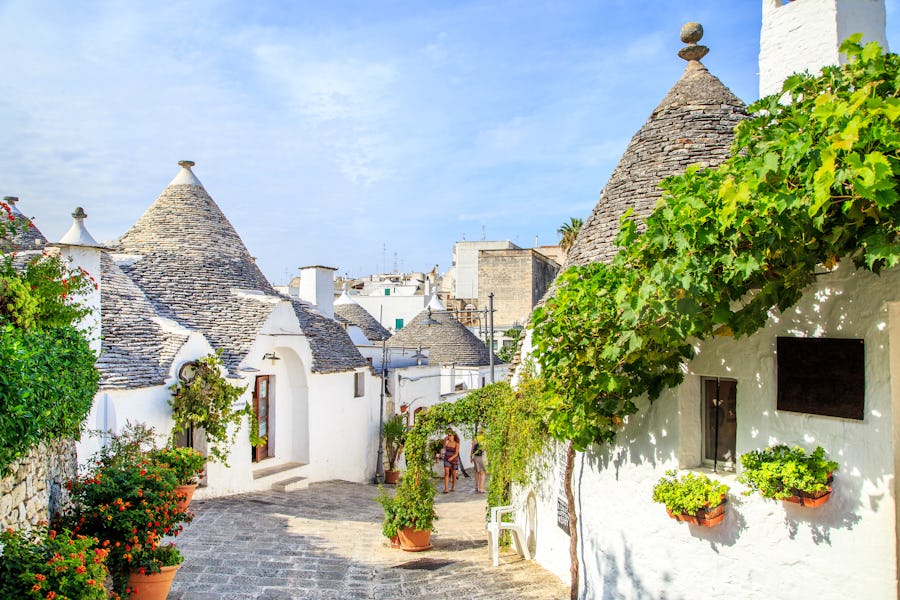
Famous for the conical-roofed trulli huts, this village has been under UNESCO protection since 1996. The whimsical 15th century limestone houses are typical for this area in Apulia. Residents assembled trulli without mortar so they be easily dismantled to avoid paying taxes. For two hours, walk around whole neighborhoods built in this style! Some houses were converted into shops and museums but most are still regular locals’ homes!
Castellana Caves

Discovered in 1938, this karst cave system is one of the largest in Italy. Stretching for 3 km, the mesmerizing tunnels run 70 metres underground. Roughly 90 million years old, ancient shellfish that inhabited the then-submerged Apulia carved out the beginnings of the cave. Today, you enter through a grand cavern named "La Grave". Its natural pantheon lets some sunlight through creating an absolutely magical atmosphere. Stop for an hour to explore 1 km of the cave, or extend your visit to 120 minutes for a longer tour that takes you all the way to the impressive White Cave.
Arrival in Bari
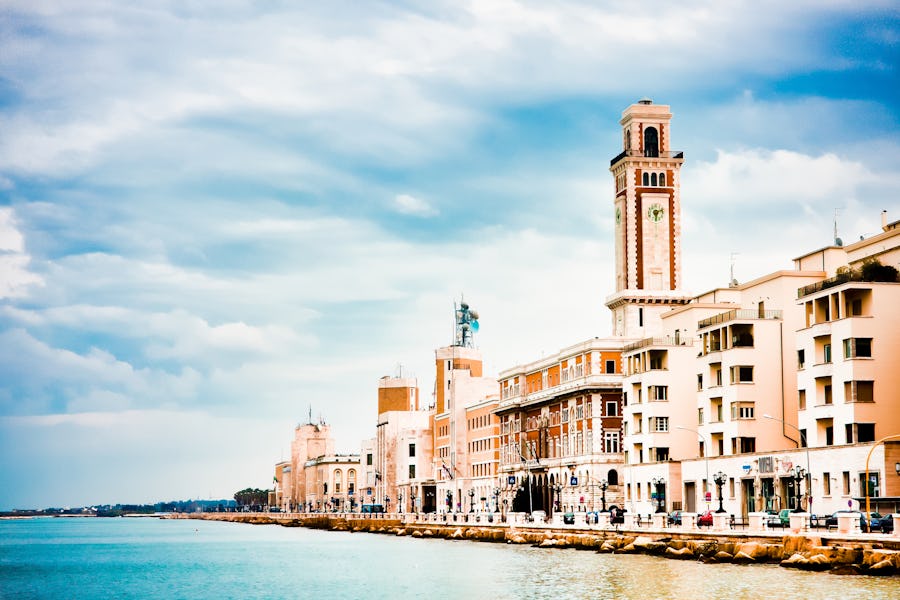
Bari has been trying to get on tourists’ radar for a while, and there’s definitely a lot to see here! The capital of the Apulia region lies on the Adriatic coast, just opposite Croatia’s Dubrovnik. Boasting one of the most scenic shores in the area, Bari has beautiful beaches right in the city!Bari’s spectacular juxtaposition of the old and the new makes it stand out from its neighbors. Bari Vecchia, the medieval old town, offers a very atmospheric experience as you get into the maze of its winding passages. Follow the cobblestones to find Basilica of San Nicola – a Romanesque-style church with splendid mosaics and a gilded ceiling added in later years. The crypt still holds the remains of Saint Nicholas, otherwise known as Santa Claus, making this church a major pilgrimage destination for Roman Catholics and Orthodox Christians. Nearby is Cathedral of San Sabino, another gem of the Apulian Romanesque style. From there head to the fantastically-preserved 13th-century Castello Svevo for the breathtaking views of the harbour.And don’t skip on the new town! The 19th-century Murat district is the heart of modern Bari. Walk the perfect grid of the streets to explore the more chic side of the city and its arts scene. Duration with stops: 7 hours and 21 minutesBook a private car from Lecce to Bari
Day 6: Bari to Naples
Once you’re ready to leave the Adriatic coast, set out on your journey back from Bari to Naples.
Castel del Monte

Built in the 13th century by Frederick II of the Holy Roman Empire, this UNESCO-protected castle is a masterful example of medieval architecture. A mathematically perfect octagon with an eight-sided tower on each corner, this fortress has puzzled many historians. Located away from the main roads and lacking any military elements, Castel del Monte couldn't have been erected for defense purposes. Take 75 minutes to examine the obsessive use of octagons throughout the structure. They're said to be a symbolic representation of the union between God and Man.
Benevento
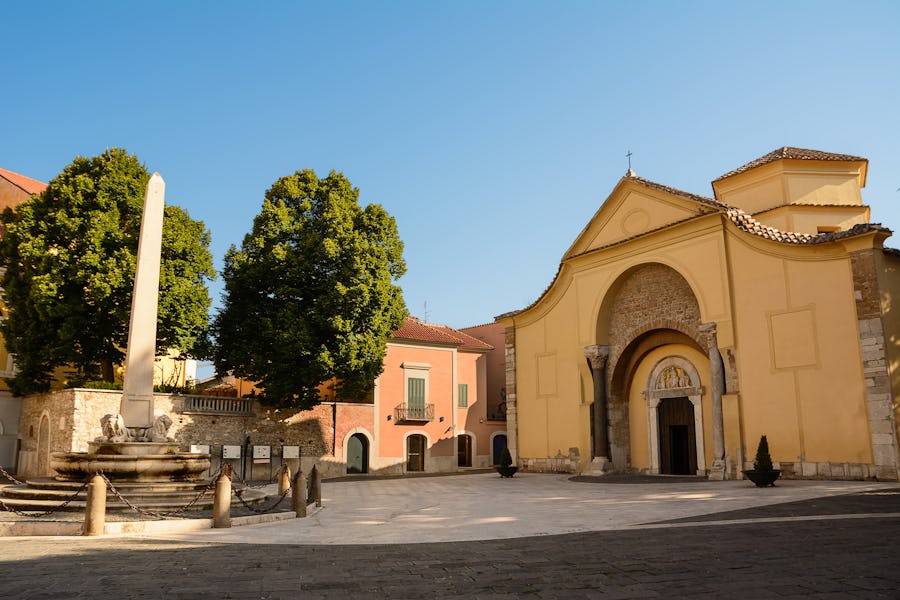
This historic city had an important role in Ancient Rome’s trade along Via Appia. Today, there's still plenty of Roman relics to discover on your 90-minute visit. The Arch of Trajan, built between 114 and 117, commemorates the successful launch of the Via Traiana trade route. The Roman Theatre, commissioned by Emperor Hadrian, still holds an occasional theatrical performance! As you wander the city, stop by the UNESCO-listed Santa Sofia church.
Royal Palace of Caserta

Recognized as the UNESCO World Heritage Site, this dazzling palace astounds with its sheer monumentality. Envisioned to rival Versailles, Charles VII of Naples commissioned the Palace of Caserta in 1752 as a new administrative center for his kingdom. The neoclassical layout of the palace followed new trends in the architecture. The opulent Baroque decorations demonstrate power and prosperity of the royal family. For your 90-minute visit, you can book a guided tour or explore the magnificent palace on your own. Make sure to dedicate some time to the park and its grandiose fountains!
Arrival in Naples
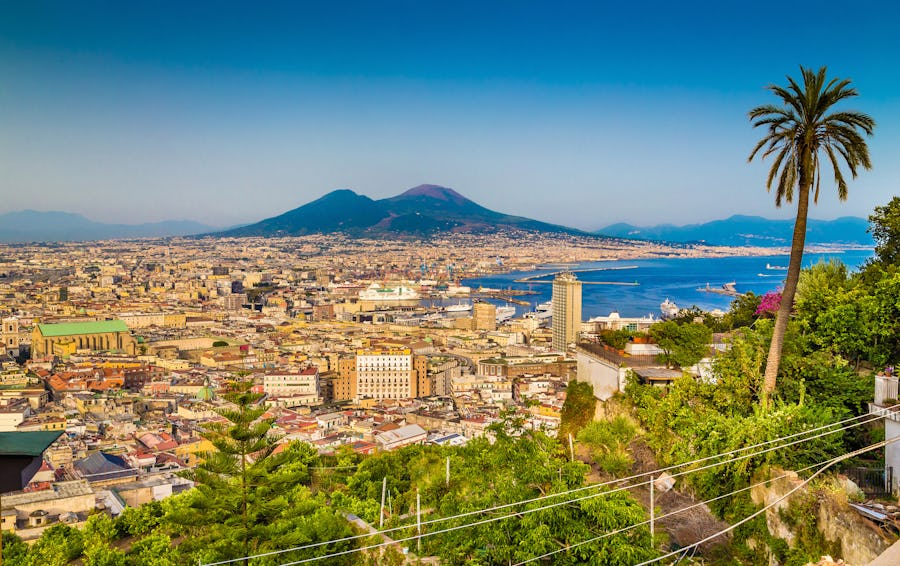
And you’re back in Naples! Now get back to gorging on delicious food and feasting on its fantastic architecture! If you haven't had your fill of Souther Italian culture, hop a flight from Naples to Sicily! We've already got a 4-day Godfather Tour planned out for you! Or head north to experience more of Italy! Duration with stops: 8 hours and 44 minutesBook a private car from Bari to Naples
Ready for your Southern Italy tour?
If you feel the South of Italy calling, here are the links for each leg of the tour.

